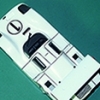Desmodromic valves can be traced back to Richard Küchen's K-motors in 1924, the 1949 Norton Manx was also before Mercedes. Ducati's first bike with desmo was built in 1950 too.
The advantage is that the engines could rev higher.
The disadvantages and why it hasn't been used that often is that there are many more mechanical parts that needed careful maintenance. It also made the engine heavier and particularly in bike racing that can be a disadvantage.
Another issue is that the additional parts required more room, which wasn't good for anything more than 2 cylinders. Ducati made the 4 cyl. Desmosedici. The adjustment time for the Desmocedici's 16 valves is said to be around 7 hours! Yikes!
Obviously these days, except for branding purposes, injection and better build quality of engines render the desmo to the sidelines.
I heard the sound of these original SS-900 bikes from one kilometre away passing by me. It's one exquisite big sound spectacle to my ears. Unfortunately not for everyone though. Other 90 degree 2 cyl engines due sound nice, I even owned a Moto Guzzi Monza, but the Ducati SS-900 was on another level in the sound department. The desmodromic valves give a very distinct sound pattern.
Edited by HP, 10 June 2022 - 03:53.
























